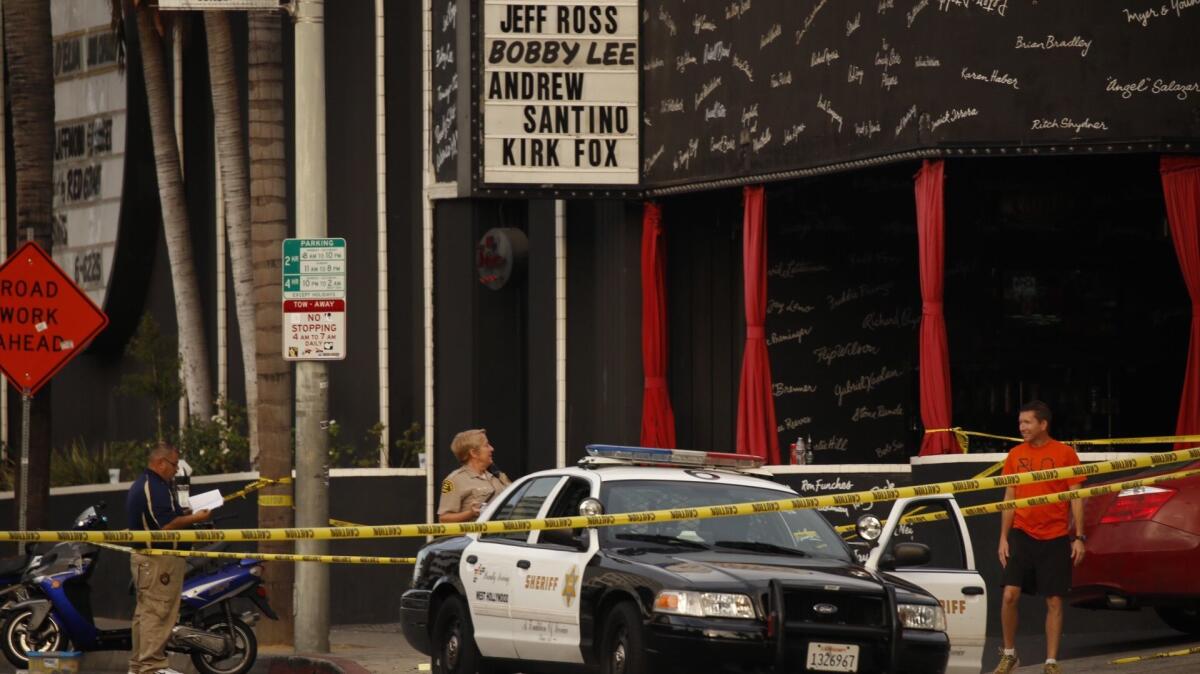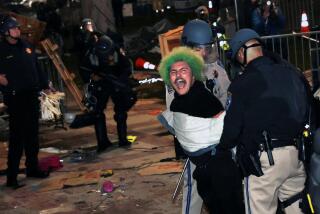Use of high-tech tool to locate shooters may greatly expand in California under proposed bill

- Share via
Reporting from Sacramento — When a man celebrating the new year fired two guns into the sky from his Sacramento backyard, a high-tech system pinpointed his location in less than a minute, allowing a California Highway Patrol airplane to capture the shooting on video. Moments later, he was arrested.
The quick response was possible because of a network of sound sensors placed throughout a community to swiftly triangulate gunshots and give officers GPS coordinates for the shootings, often within 30 to 45 seconds.
Now, one state lawmaker is looking to expand the use of the technology to communities throughout the state, including small, cash-strapped cities that might not be able to afford an adequate police force or the shot detection system. Sacramento, San Diego, San Francisco and Oakland are among 11 California cities that currently use the system, called ShotSpotter.
“It can curtail gun shooting incidents and it gives law enforcement precise information on where shootings occur so they can respond quickly,” said Assemblyman Eduardo Garcia (D-Coachella), the author of the bill.
Garcia’s bill would provide state grants to law enforcement agencies to pay for gunshot detection systems and other technology to improve policing.
Garcia decided to introduce the bill after a harrowing incident last New Year’s Eve when he and his children, ages 13 and 2, were afraid to leave their Riverside County house to celebrate at midnight.
“Before we knew it, some parts of our area started to sound like a war zone, with multiple shots going up,” he said. “I told them ’We’re not going outside.’ What goes up comes down.”
There are a handful of firms that provide technology to locate gunshots. ShotSpotter, based in Newark, Calif., has been used by some 90 police agencies worldwide.
The sensors are installed 30 feet above ground on light posts and building tops and are continually operating to register gunfire. If a loud bang occurs, the sound is analyzed in ShotSpotter’s office by experts, and if they verify that it is a gunshot and not a backfiring car, notice is provided to the police department’s dispatch center, usually within 30 seconds.
That gives officers a jump on the call and creates a significant deterrent for firing guns in neighborhoods were the system is installed, said Ralph Clark, chief executive for SST Inc., which produces ShotSpotter.
“It has allowed us to get a lot of bad people and a lot of guns off the streets,” said Sacramento police Officer Brian Airoso, part of a special team dedicated to responding to ShotSpotter calls.
Officers often get notification so quickly that they can still hear gunfire as they approach a targeted address, and they have arrived to find people still holding guns with the smell of gunpowder lingering in the air.
Shooters are usually “dumbfounded” by the quick response, Airoso said. He was there for the post-midnight arrest of the New Year’s shooter on multiple felonies, including use of a stolen handgun.
“There were [spent bullet] casings all over the ground,” Airoso recalled.
Civil libertarians say the technology should be considered only with great care and only after consultation with the communities in which it might be installed.
“Gunshot detection technology has been questioned for its effectiveness, costs and potential privacy impact on bystanders,’’ said Nicole A. Ozer, a policy director for the American Civil Liberties Union of California, which has not yet taken a position on the bill.
The privacy concern involves the potential that audio sensors could pick up the conversations of people walking by, activists say, noting cases where prosecutors have used comments recorded by sensors as evidence in court.
In 2010, prosecutors in Oakland won a conviction in the murder of Tyrone Lyles after his last words, recorded by ShotSpotter, were played in court.
Lyles shouted at his attacker, using a nickname, which helped police identify the killer, according to a report at the time in the San Jose Mercury News.
Clark said his firm has policies to address privacy concerns for the system, which is also in use in Chicago and New York City.
The system is designed to identify gunshots, not record conversations, he said, but sounds made right before and after a gunshot may be captured, as in the Lyles case. Copies of sound from the continuously running system are kept for 48 hours, then recorded over. Only short snippets of recordings with gunshots are kept longer, he said.
In the Oakland case, the victim screamed the words at his shooter right after the gunshot, so they were recorded, Clark said.
“That was not a conversation,” Clark said. “That was someone screaming out after they got shot.”
Even so, activists with the Electronic Frontier Foundation and the ACLU have concerns about potential misuse.
“Communities considering these tools should not move forward without a thorough assessment of these questions, regardless of whether grant money is available,” Ozer said.
The Los Angeles Police Department tried the technology briefly years ago, but was not satisfied with it. But officials are in discussions to possibly try the technology again, said Officer Drake Madison, a spokesman for the LAPD.
The technology has also been used by the Los Angeles County Sheriff’s Department in the City of Industry, Lynwood and the Willowbrook area. But it is not currently in use in part because of finances, said Lt. Cynthia Chavez of the Sheriff’s Department.
“It’s going to cost us a lot of money, and that’s something we have to address,” she said.
In the early days, the system had glitches.
“You’d catch roosters [crowing],” she said. “But they honed it in.”
Clark said the technology and the way it is used has improved in the last five years. Previously, cities had to analyze the sounds and decide which ones were gunshots, and that did not always work well. Now the company provides that service.
In 2015, more than half the cities using the system saw a reduction of more than 20% in gunfire, according to SST Inc.
The Sacramento Police Department likes the technology so much that it is expanding its use into a second area of the city, said police Sgt. Bryce Heinlein.
The capital city began using SpotShotter in July 2015 in the Del Paso Heights area, covering a three-mile radius. It used money raised from assets seized from criminals to pay the $180,000 cost of the first year of operations, as well as $155,000 for 2016.
Since it began operating, the technology has resulted in officers responding to 270 gunshot incidents, resulting in 310 arrests and the confiscation of 75 illegal firearms, Heinlein said.
“It’s very effective,” he said.
The approved expansion into another area of the city is expected to cost $200,000.
Garcia said he hasn’t decided how much money the state should provide and how many cities might get grants the first year. That is an issue for the upcoming budget deliberations, he said.
But he sees the state turning more to technology to make crime fighting more efficient and effective at a time of tight city budgets.
“In some communities it’s not just New Year’s Eve that gunshots are heard — it’s every other night, to the point where you have children, unfortunately, getting used to the sound of a gunshot down the street,” Garcia said. “That’s not normal and we should not allow it to become normal.”
Twitter: @mcgreevy99
ALSO
California voters approve gun control measure Proposition 63
‘This is a historic day’: California lawmakers send governor sweeping gun control package
More to Read
Get the L.A. Times Politics newsletter
Deeply reported insights into legislation, politics and policy from Sacramento, Washington and beyond. In your inbox three times per week.
You may occasionally receive promotional content from the Los Angeles Times.











